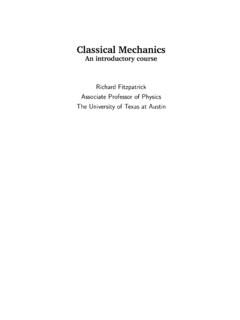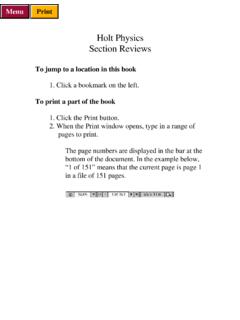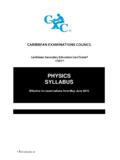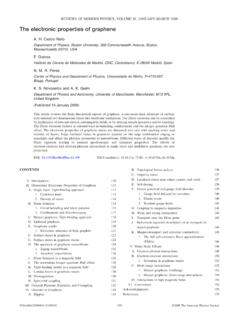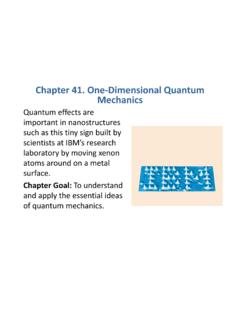Transcription of A Short History of Physics - Florida State University
1 A Short History of PhysicsBernd A. BergFlorida State UniversityPHY 1090 FSU August 28, : Most of the following is copied from Berg () History PhysicsFSU August 28, / 25 IntroductionPhilosophy and Religion aim at Fundamental is my believe that the secured part of this is happend by Trial and Error over more than 2,500years and became systematic Theory and Observationonly in the last 500 years. This talk collects importantevents of this time period and attaches them to thenames of some people. I can only give an inadequatepresentation of the complex process of scientificprogress. The hope is that the flavor get Berg () History PhysicsFSU August 28, / 25 PhysicsFrom Acient Greek: Nature .Broadly, it is the general analysis of nature, conductedin order to understand how the universe behaves.
2 Theuniverse is commonly defined as the totality ofeverything that exists or is known to many ways, Physics stems from acient greekphilosophy and was known as natural philosophy until the late 18th Berg () History PhysicsFSU August 28, / 25 Ancient Physics : Remarkable people and (ca. 570 490 BC):a2+b2=c2for rectangular (early 5th century BC) opposed the idea ofdirect devine intervention in the universe. He and hisstudent Democritus were the first to develop a theoryof (424/424 348/347) is said that to have dislikedDemocritus so much, that he wished his booksburned. Nowadays, many consider Democritiusto be the father of modern Berg () History PhysicsFSU August 28, / 25 Democritus (ca. 460 370 BC)Bernd Berg () History PhysicsFSU August 28, / 25 Aristotle, a student of Plato, promoted the concept ofnatural laws for physical phenomena, which heattempted to explain with a theory of four elements,earth, water, air, and fire.
3 He had a geocentric view ofthe universe. Aristotelian Physics became enormouslypopular in Europe with the scientific and scholasticdevelopments of the Middle Ages and remained themainstream scientific paradigm until the time ofGalilei and Berg () History PhysicsFSU August 28, / 25 Aristotle 384 322 BCBernd Berg () History PhysicsFSU August 28, / 25In contrast to Aristotle s geocentric view Aristarchusof Samos (310 ca. 230 BC) proposed a heliocentricmodel of the solar system, but received little supportfrom ancient astronomers, although his studentSeleucus was according to Plutarch (historian 46 120AD) the first to prove the heliocentric system throughreasoning. But the argument got , based on previous work by Hipparchus(190 120 BC), Ptolemy (90 168 AD), one of theleading minds of the Roman Empire, perfected thegeocentric system, so that accurate predictions ofplanetray movements became possible.
4 This was inessence a model with many adjustable Berg () History PhysicsFSU August 28, / 25 Archimedes of Syracuse (287 212 BC)Picture by Domenico Fetti 1620 Bernd Berg () History PhysicsFSU August 28, / 25 The Genius of the Antique. Foundations of Statics and Hydrostatics Mathematics of the leverFindin=Foutdout. Archimedes Screw (Pump). Archimedes Principle: Law of of Archimedes are also the only source leftfor the work of Aristarchus: His hypotheses are thatthe fixed stars and the Sun remain unmoved, that theEarth revolves about the Sun on the circumference ofa circle, ..Bernd Berg () History PhysicsFSU August 28, / 25 IntermezoMost of the direct work of the ancient world got lost(for instance, all 14 books of Hipparchus).
5 Majorevent: Destruction of the Library of Alexandria in 48BC (about 40,000 books). Dark Ages. Arabic Scientists (not covered) India and China (not covered)Hindu-Arabic numeral system 0,1,2,3,4,5,6,7,8,9. Medieval Years:Awareness of ancient works re-entered the Westthrough translations from Arabic to Berg () History PhysicsFSU August 28, / 25 Scientific Revolution Nicolaus Copernicus (1473 1543): Heliocentric. Tycho Brahe (1546 1601): Precise planetary data. Johannes Kepler (1571 1630): Music of the spheres , Phenomenological laws:1. The orbit of every planet is an ellipse with the sunat one of the two foci (1609).2. A line joining a planet and the sun sweeps outequal areas during equal intervals of time (1609).
6 A3,Torbital period,asemi-major axis(1619).Bernd Berg () History PhysicsFSU August 28, / 25 Kepler 1610 by an unknown artistBernd Berg () History PhysicsFSU August 28, / 25 Galilei Galileo (1564 1642): Birth of modernscience. Use of telescope (Jupiter moons). Inertialframes (Galileo relativity). Tried by inquisition. Isaac Newton (1643 1727): Classical Inertia. 2. Acceleration. 3. Action = Principles of Natural Philosophy (1687).Planetary motion (Newton s gravity). Calculus(modern form f(x)dxby Gottfried Leibniz). Daniel Bernoulli: Hydrodynamics (1738).Mathematical Physics : Analytical Mechanics Lagrange(1788), Celestial Mechanics Laplace (several volumes1799 1825), ..Bernd Berg () History PhysicsFSU August 28, / 25 Newton 1689 painted by Godfrey KnellerBernd Berg () History PhysicsFSU August 28, / 25 ThermodynamicsOtto von Guerricke (1650): Vacuum (pump).
7 Bernd Berg () History PhysicsFSU August 28, / 25 Boyle s Law:V 1/Pat constantT(1662).Steam Engines: Thomas Savery (1698), ThomasNewcomen (1711), James Watt (1763) preceededtheoretical developments. Joseph Gay-Lussac:P V=N R T(around 1802). Carnot Engine (1824). Robert Brown (1831): Brownian motion. First Law of Thermodynamics (Energy Conserved):Developed 1840 1850 (Mayer, Joule, Thomphson). Second Law of Thermodynamics: (Kelvin 1851,Clausius 1854).Bernd Berg () History PhysicsFSU August 28, / 25 Electrodynamics Alexandra Volta (1824): Battery. Hans Christian rsted, Andr e Marie Amp ere (1820):Current Magnetic force, Current Current force. Michael Faraday (1821): Electric (1831), independently by Henry.
8 Hippolyte Fizeau and L eon Foucault (1850):Accurate measurement of the speed of lightc. Maxwell Equations (1864) c= 1/ 0 0. Electromagnetic waves, ether (false), radio (1890). Michelson-Morley (1887), Einstein (1905):cis indendent of the motion of its Berg () History PhysicsFSU August 28, / 25 James Clerk Maxwell (1831 1879)Bernd Berg () History PhysicsFSU August 28, / 25 Albert Einstein (1879 1955) in 1921 Bernd Berg () History PhysicsFSU August 28, / 25 Birth of Modern Physics Wilhelm R ontgen (1895): X-Rays. Henri Becquerel (1896): Natural radioactivity. Joseph John Thomson: Electron (1897), Sklodowska-Curie and Piere Curie isolatedradioactive elements radium and polonium. Einstein (1905): Special Theory of Relativity.
9 (Electrodynamics of moving bodies). Einstein (1906):E=m c2. Rutherford Scattering (1911): Atom structure. Einstein (1916): General Relativity (Gravity).Cosmology (2011): Perlmutter, Schmidt, Ries, ..Bernd Berg () History PhysicsFSU August 28, / 25 Marie Sklodowska-Curie (1867 1934)Bernd Berg () History PhysicsFSU August 28, / 25 Quantum MechanicsMax Planck (1900), Bohr model (1913), HeisenbergPicture (1925), Schr odinger Picture (1926). Withcontributions by Einstein, de Broglie, Born, Jordan,Pauli, Dirac, Bose. Relativistic Dirac Equation (1928): Antimatter. Carl David Anderson (1932): Positron. Birth of Quantum Field (1950), QCD (1973), Standard Model (1975).Among many others: Fermi, Bethe, Feynman,Schwinger, Tomonaga, Gell-Mann, Higgs (Brout,Engler, Kibble, Guralnik, Hagen, Kibble), Glashow,Salam, Weinberg, Gross, Wilczek, Politzer.
10 Bernd Berg () History PhysicsFSU August 28, / 25 Dirac s Grave in TallahasseeBernd Berg () History PhysicsFSU August 28, / 25 Summary and conclusionsIt was a long journey with a 1,400years intermission. Much had to beomitted (either by space or becausethe speaker does not know any better).Could we ever fall back into darkages ? This is scary. EvenLeucippus is still how could one ever proof what he assumed?Bernd Berg () History PhysicsFSU August 28, / 25

